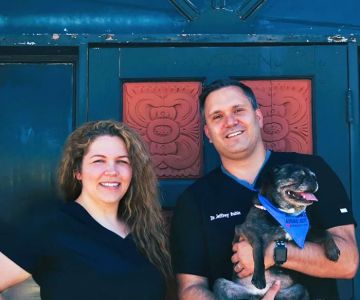How to Train Your Dog to Walk on a Leash
Training your dog to walk on a leash is one of the first and most important skills every dog owner should teach their pup. I vividly remember the first time I tried walking my dog, Max, on a leash. It was a disaster. He pulled, tugged, and didn’t seem to understand the concept at all. But over time, I learned that with patience and the right approach, leash training could become a fun bonding experience. If you're in the same boat, wondering how to train your dog to walk on a leash, you're in the right place. Here’s everything I learned along the way.
1. Understanding the Importance of Leash Training
When I first got Max, I didn't realize how important it was to train him to walk on a leash. I figured I could just attach the leash and go, but I quickly learned that dogs need to be taught how to walk properly with a leash. Proper leash training is not only important for safe walks but also for the overall well-being of your dog. It helps avoid pulling, tugging, and other undesirable behaviors, which can be stressful for both you and your dog. Plus, walking on a leash is crucial for preventing your dog from running off or getting into dangerous situations.
1.1 The Benefits of Leash Training
Leash training offers more than just safe walks. It also helps with socialization, improves your dog’s behavior, and allows you to take your dog to more places. Max, for example, became more confident and relaxed in new environments once he learned how to properly walk on a leash. Whether it’s going to the park, meeting new people, or just walking around the neighborhood, proper leash training is essential to ensuring these experiences are positive for both you and your dog.
2. The Right Equipment for Leash Training
Before you begin leash training, you’ll need the right equipment. Choosing the right leash and harness is crucial for success. I made the mistake of using a standard collar for Max’s leash training, which caused him to choke and pull harder. After some research, I switched to a harness, which distributes pressure evenly across his body and prevents discomfort. The leash should be long enough for your dog to move freely but short enough to maintain control. I recommend using a 4-6 foot leash for better control during training.
2.1 Choosing the Best Leash
There are several types of leashes available, but for leash training, I found a standard nylon or leather leash to be the most effective. Retractable leashes can encourage pulling and should be avoided during training. You also want to make sure the leash has a comfortable handle that won’t strain your hand during long walks.
2.2 The Right Harness for Your Dog
When it comes to harnesses, there are two types to consider: back clip and front clip. I personally prefer the front-clip harness for training. It gives you more control over your dog’s movements and reduces pulling. Additionally, front-clip harnesses are gentler on your dog’s neck and throat, which is especially important for puppies or small breeds.
3. Teaching Your Dog to Walk on a Leash
Once you have the right equipment, it’s time to start the actual training. Leash training is all about positive reinforcement and patience. Here’s how I trained Max, step by step:
3.1 Start Indoors
I began by letting Max wear the leash and harness inside the house. This helped him get used to the feeling of the leash without the distractions of the outdoors. At first, he was a little confused, but with some treats and praise, he began to associate the leash with positive experiences. I recommend starting indoors because it’s a calm, controlled environment that allows your dog to adjust gradually.
3.2 Keep the Walks Short and Positive
When I first took Max outside for a walk, I kept it short—just a few minutes at first. Short walks helped prevent Max from becoming overwhelmed and kept the training sessions fun. Whenever he walked calmly without pulling, I would reward him with treats and praise. Positive reinforcement is key to teaching your dog the correct behavior.
3.3 Focus on Loose-Leash Walking
One of the most important aspects of leash training is teaching your dog to walk with a loose leash. If the leash is tight, it means your dog is pulling. If your dog pulls, stop walking immediately. I learned quickly that consistency is essential. Whenever Max started pulling, I would stop walking, wait for him to relax, and then continue. Over time, he learned that pulling wouldn’t get him anywhere, and calm walking would earn him praise and treats.
4. Dealing with Pulling and Distractions
One of the toughest challenges I faced during leash training was dealing with Max’s pulling. It’s important to remain calm and patient, especially when your dog is distracted by other dogs, people, or smells. I found that using treats and a calm voice to refocus Max helped a lot. Another technique I used was the “turnaround method.” If Max started pulling or became distracted, I would simply turn around and walk in the opposite direction. This helped teach him to pay attention to me and not the distractions around him.
4.1 Using Positive Reinforcement
Positive reinforcement played a huge role in Max’s success. Whenever he walked beside me without pulling, I would reward him with treats and praise. The key is to reinforce the behavior you want to see. This not only makes training more enjoyable for your dog but also speeds up the learning process.
5. Practicing in Different Environments
Once Max mastered walking calmly on a leash in the yard and around the block, I began introducing him to different environments. This is an important step in leash training because it helps your dog become accustomed to walking in various settings, including busy streets or parks. I took Max to places with more distractions, such as the local park, and kept training sessions short and positive. The goal is to keep your dog engaged and focused on you, even in noisy, distracting environments.
5.1 Gradually Increasing Difficulty
As Max became more comfortable with walking on a leash, I gradually increased the difficulty by walking through busier areas or with more distractions. It’s important not to rush this process, as your dog needs to build confidence and learn to walk calmly in new situations. With patience, Max began to walk more confidently and without pulling, even in crowded spaces.
6. Troubleshooting Common Issues
Even with all the right training techniques, you may encounter some challenges along the way. Here are a few common issues I faced while training Max and how I overcame them:
6.1 Excessive Pulling
One of the most common issues is excessive pulling. If your dog continues to pull despite your best efforts, try using a front-clip harness or a head halter, which can give you more control and discourage pulling. Additionally, always stop and wait for your dog to calm down when they pull. This teaches them that pulling doesn’t get them anywhere.
6.2 Distractions
When training in public spaces, distractions can be overwhelming. I found that using treats to regain Max’s attention was incredibly helpful. If your dog becomes fixated on something, use a treat to redirect their focus back to you and the walk. Gradually, your dog will learn to stay focused, even when there are distractions.











